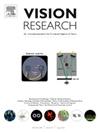Effects of repeated stimulus presentations on Oppel-Kundt and Müller-Lyer illusions
IF 1.4
4区 心理学
Q4 NEUROSCIENCES
引用次数: 0
Abstract
We present a post-hoc analysis examining whether repeated trials and multiple sessions affect the measured strength of two length illusions, Oppel-Kundt (O-K) and Müller-Lyer (M-L), as well as a non-illusory control stimulus. Data were taken from earlier studies in which participants adjusted a variable segment to match a reference segment. Short sessions featured five trials per figure, whereas extended sessions contained 24 or 26 trials for O-K and M-L. Linear mixed-effects models tested how trial number, session number, initial interval length, and figure subtype influenced illusion magnitude. O-K illusion magnitude tended to decline across sessions in the extended sessions, although individual observers displayed varying trends—some increased, others decreased. M-L illusions did not show the pronounced adaptation reported in previous work. These findings highlight the need to manage repeated presentations: controlling viewing durations, inter-session intervals, and participant strategies can help limit adaptation. Methodologically, mixing different stimuli, randomizing key parameters, and scheduling breaks appear to yield more stable measurements of illusion magnitudes.
重复刺激呈现对Oppel-Kundt和m ller- lyer错觉的影响
我们提出了一项事后分析,检查重复试验和多次会话是否影响两种长度错觉的测量强度,Oppel-Kundt (O-K)和meller - lyer (M-L),以及非错觉控制刺激。数据取自早期的研究,在这些研究中,参与者调整一个可变部分以匹配一个参考部分。在短时间的实验中,每个图有5次试验,而在长时间的实验中,每个图有24次或26次试验。线性混合效应模型检验了试验次数、会话次数、初始间隔长度和图形亚型对错觉大小的影响。在延长的测试过程中,O-K错觉的强度在不同的测试过程中呈下降趋势,尽管个别观察者表现出不同的趋势——有些人增加了,有些人减少了。在之前的研究中,M-L错觉并没有显示出明显的适应性。这些发现强调了管理重复演示的必要性:控制观看时间、会话间隔和参与者策略可以帮助限制适应。在方法上,混合不同的刺激、随机化关键参数和安排休息似乎可以产生更稳定的错觉大小测量。
本文章由计算机程序翻译,如有差异,请以英文原文为准。
求助全文
约1分钟内获得全文
求助全文
来源期刊

Vision Research
医学-神经科学
CiteScore
3.70
自引率
16.70%
发文量
111
审稿时长
66 days
期刊介绍:
Vision Research is a journal devoted to the functional aspects of human, vertebrate and invertebrate vision and publishes experimental and observational studies, reviews, and theoretical and computational analyses. Vision Research also publishes clinical studies relevant to normal visual function and basic research relevant to visual dysfunction or its clinical investigation. Functional aspects of vision is interpreted broadly, ranging from molecular and cellular function to perception and behavior. Detailed descriptions are encouraged but enough introductory background should be included for non-specialists. Theoretical and computational papers should give a sense of order to the facts or point to new verifiable observations. Papers dealing with questions in the history of vision science should stress the development of ideas in the field.
 求助内容:
求助内容: 应助结果提醒方式:
应助结果提醒方式:


